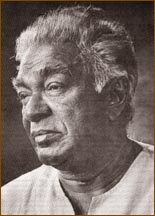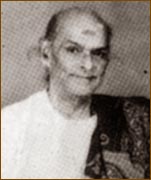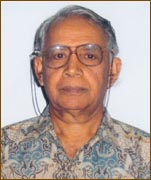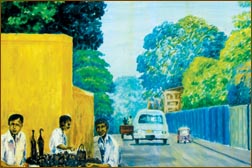|
DAILY NEWS ONLINE |
|
|
|
OTHER EDITIONS |
|
|
|
|
|
|
|
|
|
OTHER LINKS |
|
|
|
|
|
|
 |
|
A tribute to Chitrasena:Farewell: beloved muse
|
|
|
A Thespian born; and a Thespian dead but the legend of its "Muse is strong in life as in death." Chitrasena lives on in our memory as a citadel of culture, a strong monument to generations and a scion to Sri Lankan heritage.
I was eight going on nine when I first saw Chitrasena. To be quite honest, it took me time to look straight in his face. I was scared like most other kids who were new in the class but as years went by (just two to be precise) I became passionately fond of him. It was like looking up to a colossus though in short time.
When I started reading literature, especially Shakespeare, I saw many of the Bard's characters merging into Chitrasena's personality, like that of Richard Burton. And the bond grew between me and my muse and that I was when I had to give up Kandyan Dancing to study classical ballet.
But Chitrasena like Rudolf Nureyev became part of my soul. Classical dancing had beckoned me ever since I could get up and run. So, how could a soul be separated from a spirit.
And Chitrasena was body, soul and spirit. It was written in the wind, in the wide ocean that surrounded his native land and all put together, he was the muse of the past century. What Ram Gopal was to India, so was our muse to Sri Lanka.
The vibrant, restless, spectacular spirit of dance that saw many decades that embracing him, will fill many pages in history.
Day by day; year by year, his popularity grew not only nationally but internationally as well. His passion sparkled like golden rays in dancing water and its brilliance fell upon the nation that had come to revere him.
Years later when I met Chitrasena, I thought I was just another face among the thousands that had studied under him.
No; he remembered every face though we had made insignificant contribution to his beloved art. It took only a fraction of a second and that disarming smile threw me back decades to the barre on which I practised at his studio in Kollupitiya.
Chitrasena gave me a break in Nala Damayanthi but I was too young to realise the potential and persue this great art. But Chitrasena understood when I told him I was studying classical ballet under Timmy Ingleton and that I was happy doing it.
He smiled and said "One must dance as the heart says and if that is where your passion lay, you must do it." I still remember these words.
This God of Dance captivated the hearts from across the globe from the saddler's Wells Theatre in London to Moscow, Berlin, Bonn, Canberra, Perth, Sydney, Melbourne, Adelaide, Hobart, Auckland, Delhi, Bombay and many more.
This phenomenon also created an equally a strong one in Vajira. She was the medium on which he placed his chosen craft and he saw her emerging as the 'prima donna' of our era.
Chitrasena, the Sri Lanka's legendary doyen of dance never rested a minute until he physically could not cope. He also saw his dream taking shape in Upeka. He saw a future Vajira in her and this was very evident when I sat next to him for a showing of a dance excerpts by Upeka.
He was smitten with adoration for his daughter and I could see him watching without a much as batting his eye lids. To me it was like Vajira dancing and I am sure he would have felt the same but the sad part was, I had to meet this loving father-daughter duo at Apollo Hospital a few weeks later.
What is the future without Chitrasena? The Chitrasena-Vajira Academy has all their ballets in their repertory. Those wonderful ballets enshrined in Sri Lankan mythology some of which were evident over two thousand years ago, will hold good by his own generation of dancers he left behind.
Kandyan dancing would have flourished centuries ago had they been let royal patronage by our kings like how the royalty in France did to promote classical ballet. Unfortunately this did not happen except where integration of drumming and dancing heralded some sacred occasion.
So, it had to be Chitrasena who took upon himself the arduous task of doing so. He did it for his country, his nation and weaned away some bad influences left behind by some foreigners on our dance scene. Kandyan drumming exploded with this revival.
The 'Kohomba Kankariya' that was confined to remote villages, had an upsurge when he influenced Vajira to visit humorous 'Kohomba Kankariyas' that were held for days without a break and observe their significance.
This resulted in her devising a system of exercises which made relatively easy for her students. Vajira had the foresight to add these exercises to the basics that is followed by traditional Kandyan dance movements. Their foot movement synchronised excellently with the clear beat of the drums. The ideology behind all these, was the promotion of true Sinhala culture.
He gave the fillip to drumming that was only confined to temples and in the process, drumming vibrated the portals of the Saddler's Wells Theatre that had only vibrated Tchaikovsky and other Master composers. It will take a sea of ink and a forestful of pens to celebrate the achievements of Chitrasena and will not stop writers on their tracks.
They can keep discovering more and more as they explore. Few months back Chitrasena wanted to see me and show many of his unpublished photographs and documents in the hope I would write a biography if I wished to but never got round to doing it.
These are regrets one has to live with but as fate says, there is always hope. Chitrasena always had hope for the young generations that they will follow in his footsteps without polluting his beloved art and there are many to keep that torch burning.
With an aching body beset with pain, he was cheerful knowing that death was around the corner. His spirits were still very high knowing a nation loved and revered and all his good work was not in vain and that the country became richer by his dedication. He was a splendid leader towards classics and as a Thespian, he had none to rival but he respected other forms of classical dance.
A passionate guardian of the Lanka heritage in performing arts, he encouraged all students in this direction and in his wife Vajira and daughters Upeka and Anjalika, he has left the mantle to continue his passionate ardour.
'Or I shall live your epitaph to write,
Or you survive when in earth am rotten.
From hence your memory death cannot take;
Although in me each part will be forgotten.
Your name from hence immortal life shall have
Though I, once gone, to all the world must die
The earth can yield me but a common grave,
When you entombed in men's eyes shall lie,
Your monument shall be my gentle verse
Which eyes not yet created shall o'er-read.
And toungs to be your being shall rehearse,
When all the breathers of this world are dead.
You still shall live - such virtue hath my pen -
Where breath most breathes, even in the mouths of men'
Sonnet - LXXX1
Contribution of traditional and non-traditional gurus in classical Bharatha Natyam
|
|
THE traditional gurus largely contributed to the development of Bharatha Natyam. They adopted the dance and music as their hereditary profession.
These traditional gurus learned the art deeply and became involved with the art with full devotion and dedication. These gurus are generally called Nattuva Asans or Nattuvanars.
Those who learned the art under the traditional gurus directly, their approach, their understanding, their dedication, are totally different from those who learned the art under the non-traditional gurus and institutions. These traditional gurus are not performing artistes but are preserving artistes.
Most of the outstanding dancers and present teachers in this artform today are the students of these gurus. These traditional gurus not only merely impart training to the students but they impart perfect knowledge and dedication to the art.
The modern history of Bharatha Natyam starts with Tanjore Quartette. To understand the contribution of the traditional gurus, it is necessary to understand the background, and the lifestyle of the traditional gurus.
These traditional gurus not only learned the fine arts but mastered the arts. They dedicated their lives to develop and preserve the traditional art.
Senthil Annavier was the grandfather of Tanjore Quartette and contributed a lot for the development of today's Bharatha Natyam, from the early days. Mahadeva Annavaiar was the father of Tanjore Quartette.
The Thanjore Quartette, learned the dance under Gangai Muttu Nattuvanar, and Subbaraya Nattuvanar. The Thanjore Quartette as a token of gratitude to their guru and god composed Navaratna Maalai and staged it.
The Tanjore Quartette owing to differences with the Tanjavore court departed from the court, and took up residence at Orathanad.
The Quartette, were invited by the Maha Raja Swathi Thirunal to the Travancore court as court vidwans, and the offer was accepted. Maharaja Swathi Thirunal was an excellent composer of Carnatic music. He composed classical carnatic songs.
Swathi Thirunal also gifted 'Saranga Villas', as a residence to the Quartette. Eldest of the Tanjore Quartette - Sinnaiah (1801-1856) - was an incomparable teacher of dance, who composed numerous Varnams, and Thillanas which are still in use.
Ponniah the second of the Tanjore Quartette was a good composer of dances and his compositions are still in use.
Incidentally, Ponniah was the grandfather of the famed Bharatha Natya guru of the 20th century, Panda Nallur Meenachi Sunderampillai, who taught Bharatha Natyam to Rukmani Devi Arundale - the founder of the Kalashethra. Panda Nallur Meenachi Sunderam Pillai was also the guru of K. P. Sivanandam Pillai.
Third of the Tanjore Quartette was Sivanandam. He was the father of Kannuchami Nattuvanar who founded a dance school at Baroda. Kannuchami Nattuvanar was the father of the famed Bharatha Natya guru of the 20th century Ponniah Pillai.
Ponniah Pillai himself was an outstanding dance guru, a good choreographer, good classical carnatic musician, mirudangam viduwan, and excellent scholar in Tamil, and Telugu languages.
He also categorised the Adavus, into main and sub adavus. Ponniah Pillai's sons were K. P. Pittapa Pillai, and K. P. Sivandam.
K. P. Sivandam has written numerous books. Some of them are 'Thanchai Nalvar Natya Isai Karvoolam', 'Thanchai Peruodiar Per Isai', 'Aathi Bharatha Kala Manchari'. K. P. Sivanandam was an honorary principal of Swami Vipulananda School of Fine Arts at Batticaloa.
Vadivellu the junior member of the Thanjore Quartette was an excellent scholar, and an able musician, dancer, and violin viduwan, and at the age of fourteen, he was appointed as Asthana Vidwan of Travancore Palace. He introduced violin into the dance recitals.
Among the 20th century giants, K. N. Thandauthapanpillai was the composer of soul stirring songs, and an excellent guru who trained numerous artistes in Bharatha Natyam in the 20th century.
A. P. Chokalingam Pillai served at Kalashethra, and rendered the nattuvangam for Rukmani Devi's dance recitals for many years.
In 1943, owing to differences with Kalashetra A. P. Chokalingam Pillai left the institution. Vazhuvoor tradition which grew as a family institution, remains within the family to this day.
Late Padamsree, Vazhuvoor Ramaiah Pillai, the foremost Bharatha Natya guru of the 20th century learnt the art under his maternal uncle Manikampillai. Vazhuvoor Ramiah Pillai's style of rendering nattuvagam and choreography was incomparable.
In the Kanagasabesar temple, in the little village of Vazhuvoor, there is an inscription which states that Vazhuvoor gurus taught dancing to Chola princess.
Among the gurus of Vazhuvoor tradition, were Vazhuvoor Samaraj, Swamy Mali S. K. Rajaratnampillai and presently Vazhuvoor Palaniappa, and Mombai S. K. Kameshwaran.
Others who have contributed for the development and for the growth of Bharatha Natyam are D. K. Kupiyapillai, K. Mahalingam Pillai, D. K. Kaliyanasunderam Pillai, Kathiravelupillai and Ramaswamy Bhavathar.
These traditional gurus strictly adhere to high standards in Bharatha Natyam. They hardly depart from the devotional aspect of the art. They preserve the divine art with deep devotion, and dedication. All their compositions are very traditional and deeply devotional and unique.
But unfortunately today most of the students do not have an opportunity to learn the art under traditional gurus.
Most of the students learn the art under the non-traditional gurus. These non-traditional gurus introduce lot of innovations in adavus, and choreography, and borrow a lot of ideas from other dance forms and from the silver screen.
For instance the adavus cannot be traced to their source as they use many twists, turns, and jumps in adavus. In the name of innovations they choreograph a lot of normal social themes, instead of traditional devotional themes.
These tendencies cannot be found among the traditional gurus. The non-traditional gurus argue that the art must reflect the social problems, and self creativity. That could be possible only for the modern arts and not for traditional art forms.
Paintings on 'Nature's Innocence'
|
|
"NATURE'S INNOCENCE", an exhibition of paintings by D.M. Jayasekera who is better known as Dissa Jayasekera will be held at the National Art Gallery on July 30 from 10.00 am to 5.30 pm.
This is the first exhibition by Jayasekera and it comprises 25 paintings. "These paintings have been done using acrylic paints. Most of these are landscapes", Jayasekera said.
"My paintings depict nature and its innocence", he said.
Jayasekera had started painting in his schooldays. "I was influenced by the paintings of German painter 'Karl Wagon' who held an exhibition in Badulla in 1951 when I was attending school."
|
|
"I learned his technique before entering university in 1959. I did several paintings until about 2004. I had no chance to do any paintings thereafter due to pressure of work", he said.
He graduated from Peradeniya University obtaining a degree in economics. "Since then, I was employed in three different Ministries. At present I am attached to the Ministry of Finance of Planning as Director of the National Planning Department."
Jayasekera also served as the first Chairman of the National Transport Commission.
Jayasekera will display 25 paintings at the forthcoming exhibition.
|
|





